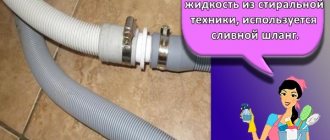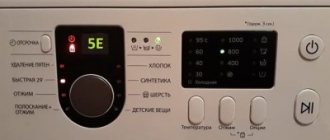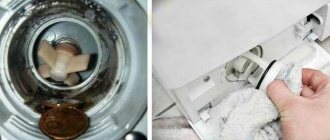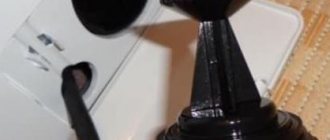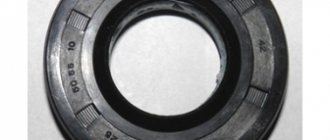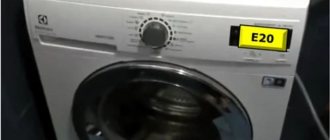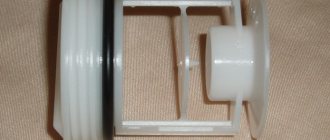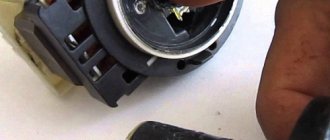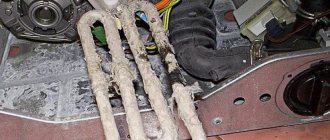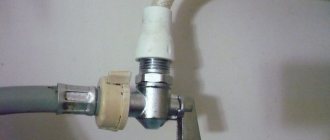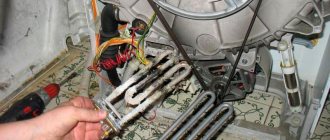According to statistics, blockage is the most common problem of any SMA. If such a malfunction occurs often, then it is inconvenient to call a technician to your home every time, and even more so to transport the washing machine for service. You can figure out on your own what to do if the hose in the washing machine is clogged.
It is a mistake to think that to remove a blockage in a hose it is enough to simply wash it. First you need to understand where it is and how to remove it correctly so as not to damage it. But nevertheless, eliminating the blockage is an easy task, and all its stages are described below.
Flushing
It is not difficult to clean the lumen of the removed drainage.
First you need to prepare a basin that can accommodate the drain hose. You will need to heat the water to a temperature of 60-70 degrees and prepare the detergent. Procedure:
Inspect the tube for integrity. Using a long, thin stick, remove any mechanical blockage if present.
If this cannot be done, the hose must first be washed and then cleaned. Immerse the tube in water, after adding an aggressive detergent, for example, for cleaning stoves, and leave for 30-40 minutes. Put gloves on your hands and arm yourself with a sponge. Take out the hose, wipe its surface with a sponge and wash with running water. Clean the inside. Treat the outer and inner parts with detergent, place in a bathtub or empty basin and leave for 20 minutes. Clean off any remaining dirt and rinse well under running water. Wipe and dry. Attach it back to the washing machine, securing it with a clamp. Reassemble the device in the reverse order, paying special attention to tightness. When the drain hose is installed, run the quick wash mode for preventive purposes. Expert opinion
Expert opinion
I work in the household appliance repair industry. Extensive experience in restoring washing machines and dishwashers.
Ask a Question
Important! Prepare in advance a thick and stiff wire or a thin stick, which can be used to clear the resulting blockage. Its diameter should be no more than ½ the thickness of the hose
There is another quick option. You need to attach the end to the tap. Turn on hot water under acceptable pressure. Use your hands to stretch and compress the hose corrugation. If the washing machine has been in use for a long time, a lot of deposits will come out, possibly causing a bad odor.
Go to menu
Cleaning the drain hose
The problem can be solved in several ways. Contact a repair shop and try to solve this problem without the help of a technician. After all, he will not come right away. You will have to wait for his arrival, and the laundry will gradually accumulate. In principle, most washing machine owners can clean the drain hose. This work does not require special knowledge or professional skills.
Blockage
A clog is defined as a buildup of debris that prevents fluid from draining from the hose. It is divided into several types:
- Mechanical. The filtration system is clogged. Various small objects, such as buttons, often end up here.
- Natural. When washing, the drainage system begins to clog. Hair and various small particles accumulate inside. As a result, the hose becomes impassable.
A blockage can be called a powerful drain blocker. As a result, the washing machine does not operate in the established modes.
Signs of a clogged drain pipe
When a blockage appears, the program begins to go wrong. This is determined by the following criteria:
- indicators start flashing;
- the speed of the drain flow decreases;
- the machine begins to hum loudly;
- The touch panel does not work;
- there is a constant shutdown;
- The electronic system is triggered, the machine turns off at the moment of draining.
- Instead of draining, the “rinse” mode is activated.
To deal with the problem yourself, you need to first familiarize yourself with the design of the washing machine and understand how the drain system works. The manufacturer provides all the information you are interested in in the instruction manual.
How does the drain system work?
Before the final drainage begins, the water enters a storage tank connected to a cleaning filter, where all kinds of small particles and small lumps of dirt settle.
After purification in the filter, water is supplied to the impeller. Only after this does it begin to drain. The impeller, rotating at high speed, creates pressure that pushes water through a flexible hose. A blockage may occur along this path, in any area.
Types and location of pipes
Suppose you own a modern washing machine, and it makes no difference what brand it is - Kandy, Indesit, Ariston, Electrolux or Atlant. Each model can be equipped with up to three different pipes:
- aspic,
- drain,
- dispenser.
Each element is distinguished by its coordinated work; liquid moves between them. Now let's figure out how this process happens.
The filler pipe is used to connect the intake valve and the SMA dispenser. The liquid moves quickly through it, enters the tray for washing powder, dissolving it, and in the form of a mixture passes into the dispenser hose, which connects the tank and the tray. Through the pipe, water enters the tank, after which the washing process begins according to the mode you set.
As it becomes necessary to drain the waste liquid, the drainage pump is activated, pumping water from the tank into the drain pipe. After passing through the entire drainage system, dirty water goes into the sewer. It follows that each of the three pipes is capable of losing its functionality prematurely due to the formation of scale inside, blockages or mechanical damage.
In modern washing machines, the pipes are made of durable and elastic material, but after a long period of use they harden and can crack, causing leaks. It’s also a shame that residue from the remnants of low-quality powder collects and hardens in the dispenser hose. However, the drain pipe suffers the most vulnerability. This is due to the fact that waste liquid passes through it, which may contain small foreign objects - cufflinks, pins, buttons, etc.
And if your washing machine leaks, you must first make sure that the drain pipe is not damaged. After this, all that remains is to repair and change the filling and dispensing pipes.
Tube connection diagram
In most cases, the drain hose is connected inside the washing machine directly to the pump. To clean it, you will need to disassemble the washing machine. Even if the drain is connected directly to the back wall, it is better to disassemble it, since there will be another tube from the pump itself to the back wall. From the machine, the drain pipe is connected to the sewer system.
Depending on the model of the washing machine, there are several options for accessing the pump, and therefore for removing the drain pipe:
- access through the rear wall;
- access through the bottom of the machine;
- access after removing the front cover;
- access after dismantling the side wall.
In some models there is no need to additionally disassemble the housing of household appliances. For example, some manufacturers do not cover the bottom of the machine with any plugs, and if access to the tubes is through the bottom, then in this case nothing even needs to be disassembled.
Repairing the dispenser pipe
And this element periodically requires cleaning or repair. First, let's figure out where it is. In certain machine models, it is removed in the same way as the filler element - through the top of the washing machine. But there are units in which the dispenser pipe can be dismantled by first removing the front cover of the machine.
The clamping screws securing the pipe are unscrewed, which is carefully detached from the tank and dispenser. The element is inspected for blockages and other damage; if necessary, it is replaced with a new part.
In words everything is very simple, but practice proves that getting to the clamping screws is quite difficult. It should also be remembered that many machines have a flow filtration mesh on the tank neck. During dismantling of the pipe, it may fall out, and quite often they forget to put it back in its original place.
How to clean a drain hose that is partially clogged
This often occurs due to a clogged drainage system. There are two ways to solve this issue, and you can do it yourself. Method one is to clean the drain hose without disconnecting it from the washing machine. In case of partial blockage, when the water begins to drain more slowly, it is possible to eliminate this problem without disassembling the drainage system. This is usually caused by the settling of detergent particles and small lint and fibers that have passed through the drain filter.
There are various products available on the market to dissolve deposits that form on the inside walls of the drain hose. Before use, you must study the instructions for use, usually it is a powder or solution, sometimes found in tablet form. There is no need to worry that the use of these drugs may damage gaskets or seals. Washing machines produced by well-known global manufacturers have high quality components.
If you have doubts about the quality of the connections and gaskets, you can wash the drain hose with baking soda. To do this, you need to add 100-150 grams. soda directly into the drum and turn on the washing machine without laundry in the “cotton” mode.
If water removal from the washing machine completely stops, a second cleaning method will be required, in which you will need to completely disconnect the hose from it. For this you will need the simplest tool - a flat or figured screwdriver and pliers. The sequence of actions in this case is quite simple:
- Disconnect the washing machine from the power supply.
- Shut off the water supply.
- Carefully disconnect the hose from the machine, first placing a container to drain the remaining water.
- Disconnect the drain hose from the sewer and clean it.
To de-energize the washing machine, simply remove the plug from the socket. There is usually a tap on the hose that supplies water from the plumbing system; it should be closed. Basically, the drainage hose is attached to a pipe, which is located on the back of the washing “unit”. Using a screwdriver or pliers, you need to unclench the retaining clamp and remove it. For ease of access and operation, first place the washing machine on its side, placing a floor or other cloth under it. Sometimes users do not connect the drain to the sewer, but simply place the other end of the drain hose in the bathtub or sink.
Cleaning should be done with a Kevlar cable, at the end of which there is a small brush; you cannot clean it with metal objects. After cleaning the hose in one direction, the operation should be carried out in the other, then rinse well under running hot water.
To be more sure that the hose will not have to be removed again, it is recommended to inspect the filter as well. Perhaps it also requires revision and cleaning.
Different manufacturers have their own housing designs and filter mounts that require access. Trademarks LG, Veko, new Indesit models, the bottom is closed with a lid that can be easily removed with a flat screwdriver. Zanussi, Electrolux to access the filter you will need to remove the back panel. German manufacturers of washing machines - Bosch, Siemens - made the front panel removable. Then, depending on the design, the filter is removed. It is attached to the body using latches or a screw connection (bolt, self-tapping screws), sometimes it is screwed into the drain pipe. To dismantle it, you may need to remove the neck to which the drain hose is connected. The work must be carried out carefully, without damaging the gaskets and seals.
The filter should also be thoroughly cleaned and rinsed under running hot water. Then reassemble in reverse order. All connections must be tightened well, especially the hose clamp itself. The pressure when water comes out is small, but it is still there.
After the machine is assembled and connected to the power supply, it is advisable to wash it with a cleaning agent to completely remove small particles. In addition, you should inspect the connections for leaks and, if necessary, tighten the clamp.
For prevention, once every 1-2 months it is advisable to wash the machine to remove clogs and scale; in areas with high water hardness, use water softening agents. It is also recommended to use a special bag for washing.
https://youtube.com/watch?v=xZn7-uTPoYQ
You might be interested in
You can leave the first comment
Updates on the site
2015-2018 – All rights reserved
When copying materials, an active and indexed link to the source site is required.
Changing the drain hose in LG and Samsung washing machines
In machines from such companies, the pipes through which water from the tank passes into the pump are located at the bottom, and access to them is quite easy.
To replace this element, the washing machine should be tilted on its side. To prevent water leakage during repair work, it is first drained, for which the machine is switched to the spin-out and drain mode. After this, the cover of the filter element opens and the machine is completely freed of liquid.
Now washing machines from LG and Samsung are disconnected from the electricity and water pipe, the inlet pipe is unscrewed. The machine is laid on its side to gain access to the rubber hose. You will have to perform a certain algorithm of actions, for which you will need pliers and a Phillips screwdriver:
- the clamp opens, the hose is disconnected from the pump,
- Now we loosen the fastening that secures the hose to the tank,
- The pressure take-off chamber is unscrewed from the top of the tank. This is necessary in order to easily remove the clamp located on the pump,
- a new hose is installed, all steps are performed in the reverse order.
How to restore whiteness and freshness to a toilet using folk remedies
If going to the toilet becomes unpleasant because there are noticeable stains and an unpleasant odor inside, try cleaning the toilet with a brush. If you are not pleased with the result, move on to more serious cleaning methods. Folk remedies are well suited for cleaning minor and old deposits in private houses and apartments that have a plastic pipeline or a local sewer/cesspool system.
With prolonged exposure, vinegar can dissolve hard urinary stones and limescale without damaging the surface of the toilet.
To clean the toilet:
- Use a plunger to clean out the sewer system and pump out the water from the toilet.
- Wipe dry areas that require treatment.
- Moisten a cloth generously with vinegar and apply it to the plaque.
- After 6 hours, clean the toilet and remove any remaining residue with a non-metallic scraper.
To enhance the effect, you can use heated vinegar essence or vinegar-soda solution (1 tbsp soda for 1 tbsp acid). The processing mechanism is the same as when washing with pure vinegar.
Folk remedies are no less effective: pour ½ pack of soda with 1 tbsp. water (scoop out the water from the toilet first). After 15–20 minutes, pour a kettle of boiling water into it so that the dissolved blockages go into the sewer or street cesspool.
If you have a problem with how to clean a dirty toilet, use special or folk remedies. Use aggressive ones, like hydrochloric acid and autoelectrolytes, in extreme cases, because they are dangerous for the drain system.
For complex household appliances, which includes a washing machine, preventive maintenance is necessary. Otherwise, active use will quickly damage the machine.
Therefore, we have prepared an instructional article about cleaning the filter and the main problems that washing machine owners encounter during cleaning.
How to clean a drain hose with your own hands
If you do find a malfunction that arose due to a clog in the drain hose of the washing machine, then first of all you need to ensure full access to the drain system.
Cleaning the filter
The filter system is located at the bottom of the washing machine, on the right, behind a small door with a hatch. In order to open it, you need to pry the edge of this hatch with your fingers or some kind of flat, blunt object. In some models, the panel can be opened by pressing the latch or by bending the rotary hooks.
Clean the filter in the following sequence:
- Unscrew the screw and carefully remove the filter.
- We tilt our structure, drain all the available liquid, having previously placed a container with low sides for this purpose.
- After there is no water left in the machine, we remove all foreign objects that are stuck. If structural elements are completely covered with scale, they must be completely replaced.
- Next, when you have already removed the dirt by washing with water and wiping with a damp sponge, inspect the place where the filtration system is located and remove the remaining dirt from the walls.
- Clean the pump and the adjacent system, and then connect your device to power and enable the drain mode. If you did everything correctly, the blades and impeller of the pumping system will rotate without interruption.
All the details can be found in the video review, which describes the process in detail.
Attention: there are exceptional situations when the system is so dirty that it simply cannot be removed. In this case, it is recommended to remove one wall of the washing machine and carefully clean the filter from the side of the pumping system.
Disassembling the drain pipe
It is also possible that the flow of liquid will simply be blocked, even just at the junction with the sewer pipes. To clean the drain in this case, you need to disconnect the hose.
Everything is carried out in several stages:
- Unplug the washing machine.
- Close the water supply valve.
- Using a flathead screwdriver, remove the side or front bottom panel.
- Pour the remaining used water through the drain filter.
- Using pliers, disconnect the end of the hose from the sewer pipe or trap.
In devices from brands such as VEKO, Ariston, Candy, Samsung and Indesit, you can only get to the drainage hose through the bottom. In such cases, to make it easier to clean the washing machine from blockages, place your unit on its side, placing some cloth under it in advance. After you open the clamp with pliers, you can safely disconnect the hose from the pump.
In Electrolux or Zanussi washing machines, the hose runs along the back wall. To get to it, remove the back cover of the case. Next, we open the latches, unfasten the drainage hose, and then unscrew it from the water supply hose. To completely remove the drain hose, you should completely remove the top cover by unscrewing all the bolts and loosening the clamp to secure it.
In machines such as Bosch and Siemens, you can get the hose by removing the front panel of the case. Everything is done in the following order:
- Remove the sealing rubber from the front panel and unclench the clamp.
- We take out the bottom panel and the retractable tray for detergents.
- Unscrew the bolts to secure it and remove the hatch door lock.
- Remove the front panel of the case.
- Unclench the clamp and pull out our hose.
Cleaning the washing machine drain hose
Clean the drain hose by washing and treating the walls from the inside using special brushes. Masters in this business are accustomed to using not metal brushes, but those made of synthetics.
To clean the walls from the inside, the cable is inserted into the contaminated hose and moved back and forth. After this procedure, you need to rinse the hose with water. If the contamination cannot be removed the first time, the procedure should be repeated.
Helpful advice: in order for you to achieve the best effect when washing, use warm water with citric acid added to it.
The hose, washed from all sides, just needs to be fixed in its old place, performing all the described steps in reverse order.
How to find and clean the filter yourself
It should be noted that in almost all brands of washing machines the filter is located in approximately the same place. The main requirement for its location is free access and ease of cleaning activities.
Removing the filter
Most often, the filter is located at the bottom of the machine facade on the right side. It is covered with a panel that can be removed using any flat object, such as a knife. Some older models do not have a protective panel, so the filter cover is visible. To remove the device itself, you simply need to unscrew it counterclockwise.
In some brands of washing machines, the filter element is covered with a rectangular panel that can be opened by pressing it. There are models in which the panel is held in place by a latch. That is, there are many variations in how the protective panel is closed. The manufacturer usually indicates the opening method in the product data sheet.
Attention! There are models of washing machines in which access to the filter is hidden under the wall of the device housing. Therefore, this wall will have to be removed.
Filter locations
Most often, the filter itself is connected to the drainage system with a threaded structure. That is, the thread is applied both to the housing where the filter element is inserted, and to the filter itself. This is a simplified system because it does not require tools when unscrewing. But in some designs, the filter is attached to the machine with a screw, which must first be unscrewed with a screwdriver, and only then the device itself must be pulled out.
The most interesting thing is that the design of the filter itself is very simple. Essentially, this is a mesh cylinder made of plastic, with the help of which the pipe connecting it to the drum of the washing machine is blocked. It is the mesh that prevents dirt and small objects from entering the pump. After all, if it becomes clogged, not only will the entire drain system stop, the pump will simply jam and burn out, and this is already a serious breakdown. Therefore, cleaning the filter of a washing machine is a simple matter of removing foreign objects and washing the mesh from dirt.
How to properly clean
The algorithm of action is actually simple. But there are some nuances in this process that need to be paid attention to.
- Before unscrewing the filter, it is necessary to place a container under its installation location, where the water remaining in the drum and in the rubber pipe will be drained. In this case, it will be better if the washing machine is tilted forward. In principle, you can place any object under the body of the unit, or you can hold it at an angle with your hands.
- The filter is being cleaned.
- You can use your fingers to check the rubber pipe for dirt and small objects. If there are any, then they must be removed.
- The same goes for the pipe connecting the filter and the pump, although nothing can pass through the filter element.
- The filter is installed in place, the machine is turned on in the “Drain” mode. That is, it is necessary to check whether the clogged drain in the washing machine was removed.
- If even when the pump is running, the liquid does not drain from the washing machine, then the problem is in the drain hose. It needs to be removed and cleaned. There are no small objects in it, that's for sure. But long-term operation of a household appliance creates conditions under which soapy layers mixed with threads, hair, wool, and so on can form on the internal surfaces of the hose. The deposits can be quite large, which leads to the formation of a blockage.
Such a defect in the drainage system of the washing machine can be removed by removing the hose and washing it, or better yet, replacing it with a new one. It is directly connected to the pump and secured to its outlet pipe with a metal clamp. Removing the clamp is not difficult, you only need a screwdriver, but the main thing is to get to the connection point. From a purely constructive point of view, this can be done by removing the wall of the machine or its bottom.
How to disassemble and clean the sink siphon - the simplest and most reliable way to remove a blockage
If you have already tried to break through the blockage in the sink using folk or chemical remedies, but the water still stands or drains slowly, then most likely you need to clean the siphon. Fortunately, even a child can take it apart. All you need is: 15 minutes of free time and a screwdriver or coin.
Step 1
Unscrew the nut that is located above the siphon reservoir and carefully remove it
It is advisable, before disassembling the siphon, to place a basin under it for occasional puddles and to collect dirt. And, of course, don't forget to wear rubber gloves.
Step 2. Hold the siphon in one hand, and with the other hand disconnect the drain hose, unscrewing the nut between them. Next, we move the siphon and drain hose to the side (for example, into a basin), and at the same time remove the dirt that falls out of them.
Step 3. Now unscrew the drain grate in the sink using a screwdriver or coin (most modern grates can be unscrewed with a coin).
Step 4. Unscrew the top nut on the remaining pipe and take it out of the sink along with the already unscrewed drain grate. Hooray! The siphon is disassembled.
Step 5. Wash all the parts. To thoroughly clean the siphon, unscrew the flask from it.
Step 6. We assemble the siphon in the reverse order: install the drain grate and pipe, secure it with a nut, then assemble the siphon, connect it to the drain hose and, finally, screw it to the pipe. Ready! We check whether the blockage has been cleared and are proud of ourselves.
What is a pipe?
This is a corrugated piece of hose that is used to connect the inlet and drain holes to the corresponding points in the laundry washing machine. The pipes, unlike hoses, are located in the body part and are not visible to the user. Some people don’t even suspect that such elements exist in the car. As a rule, the first acquaintance begins after the car leaks. And here inexperienced users begin to make the main mistake - they are looking for something to glue the pipe to the hose or tank.
Causes of clogging and their prevention
What is the cause of the blockage? Dirt and debris from the water supply or clothing, as well as low-quality powders that, instead of dissolving in the water, clog the pump. Therefore, there are two types of blockages: mechanical (from debris) and natural (from the smallest particles of clothing accumulated on the filter). A natural blockage forms in the drain system in any case, albeit slowly, so if you never clean the drain system of your machine, it will definitely clog at the most inopportune moment.
In order to reduce the number of “cleanings” of the drainage system in the future, it is enough to remember simple rules:
- It is better to wash clothes with loose “decorations” in special bags.
- Do not use low-quality washing powder.
- Once a month it is worth cleaning the drain system of the machine.
- Before each wash, check everything, even the smallest pockets of your clothes, for forgotten items, garbage or papers.
- Fasten zippers and buttons before washing.
And remember, your washing machine also needs care, and then it will serve you well for a very long time.
Attention, TODAY only!
It is recommended to clean the filter and completely drain the water at least 2-3 times a year.
If this procedure is carried out regularly, then damage to the drain pump can be avoided for a long time. Sometimes there are cases when cleaning the filter becomes necessary, for example:
If the washing machine does not drain water or the spin cycle fails;
If the display shows the message “Clean the pump”;
For this:
1. Disconnect the washing machine from the electrical outlet.
2. Open the bottom panel or the cover on the panel that covers the filter.
Or so
3. Prepare a container and place it under the filter on the right side.
4. Open the filter slightly. Do not remove completely. Gently turn the filter counterclockwise until water begins to flow out.
5. Wait until all the water has completely drained out, unscrew the filter completely and remove it.
or so
6
You can carefully tilt the machine forward to allow the remaining water to drain out completely. 7. Clean the compartment where the filter was located and the filter itself.
Clean the compartment where the filter was located and the filter itself.
7. Clean the compartment where the filter was located and the filter itself.
8.Check that the drain pump impeller rotates freely.
9.Place the filter in place and screw it clockwise until it stops.
10.Reinstall the bottom panel (or panel cover) into place.
11.Plug in the washing machine.
If you have a model with an emergency drain hose, then remove the base (or panel) as described above. Then remove the emergency drain hose and place the water container at such a distance that the hose can reach it. Remove the cap from the hose and allow the water to drain into
capacity. Cleaning the filter should be done as described above. Then install the plug on the hose and install it in place at the base of the machine.
Despite the fact that the washing machine is a “helper” in maintaining cleanliness, it itself also needs care and cleaning. If one day while washing, you hear an incomprehensible buzzing noise coming from the machine that you have not heard before, and the machine does not drain the waste water, this means that it urgently needs to be cleaned. Most likely, the drain pump is clogged, or in the worst case, the pump fails. That's why we decided to tell you how to clean the drain pump in a washing machine on your own, without the help of a professional.
Procedure for cleaning the washing machine filter
It is important to carry out this procedure carefully, in strict accordance with the rules. It is important not to use excessive force during this procedure so as not to damage the parts of the filling and drainage systems of the washing machine.
Means used
To clean the filter for water coming from the water supply, you will need:
- pliers;
- old toothbrush;
- a little soap solution.
To clean the drain filter, you will need to prepare the following:
- screwdriver;
- pliers;
- a kitchen sponge, which is usually used for washing dishes;
- flashlight;
- shallow container or rag.
It is convenient to clean both nodes during one procedure.
Direct extraction and cleaning
During the cleaning process, you will need to remove the filter and clean it thoroughly. This must be done in accordance with the proposed sequence of actions.
Fill filter
Cleaning the inlet filter is much easier compared to servicing the drain filter.
The work procedure includes the following steps:
- Before you begin, you need to disconnect the machine from the network.
- You need to disconnect the hose through which tap water should flow into the washer.
- It will be convenient to use pliers to remove the filter. It must be remembered that it is a metal mesh.
- The dirt and debris that have accumulated there must be removed from the filter. To do this, it is recommended to use an old toothbrush or something similar. During work, it is prohibited to use any chemical cleaning agents. The only allowed option is a soap solution. In this case, the water should be warm.
- After cleaning is completed, the mesh is thoroughly wiped and put back in place.
- Now you need to put the filter in place.
After completing the procedure, the inlet hose is installed in its original place.
Drain filter
Cleaning the drain drain filter is done as follows:
- Before starting maintenance, the washing machine must be disconnected from the power supply.
- At the bottom of the front wall of the car you can see a small hatch. You need to remove its cover. To do this, you can use a screwdriver by prying it off the edge. To remove this panel, you need to move it slightly to the side or pull it towards you.
- Usually the drain system does not dry out completely. To prevent water from getting on the floor, place a rag under the hole. After the filter is opened, some liquid will spill onto it. Instead of a rag, you can use a small container for water. Some models provide a special hose to remove water in such cases.
- Now you need to unscrew the filter and take it out. On some models, you may need to remove a plug or unscrew a security bolt.
- Now you need to directly start cleaning this unit. First you need to carefully inspect the filter. First of all, various small debris that gets there along with the flowing water are removed from here. In this case, hair, coins, matches, threads or other such objects may come across.
- Next you need to clean off the plaque. To do this, you need to scrub it thoroughly with the hard side of the sponge. Do not use aggressive cleaning agents or hot water for cleaning. Otherwise, it is possible to damage the plastic parts and sealing rubber.
- Next, you need to inspect the hole where the filter was located and thoroughly clean it of debris and dirt. To do this, just wipe it with a soft and damp sponge.
- Now you need to clean the pump and pump. To do this, you will need to shine a flashlight into the hole and remove any dirt found.
- After cleaning is completed, the filter must be carefully put back in place. When tightening it, you need to do this with precise movements in accordance with the location of the thread. Do not apply significant force during installation. Otherwise, the thread may be damaged and the unit will need to be replaced.
- You need to make sure that everything is installed tightly.
After completing the procedure, a check must be carried out. To do this, connect the hose and turn on the washing machine in test mode, without loading laundry. It is necessary to ensure that no water leakage occurs after the maintenance procedure.
Now we need to put the false panel of the small hatch in place. After this, the cleaning procedure will be completed.
If you have difficulty unscrewing
If you cannot unscrew the part with minimal effort, there is no reason to be nervous.
All it takes is a little more effort. If your hand slips, it is enough to use a dry towel or rubber gloves to grab it.
If you still cannot unscrew it, then the most likely reason is that the blockage is very serious. In this case, you need to try to unscrew it even using force. Otherwise, you will have to call a specialist from the service department.
Instructions for cleaning the drain hose
The drain hose is disconnected with its own characteristics depending on the washing machine.
For example, when working with equipment from LG, Samsung, Indesit, you need to approach the pump through the bottom:
- Remove the bottom (or bottom panel).
- Remove the filter elements.
- Unclench the clamp and disconnect the drainage system pump.
- Disconnect the hose.
For Electrolux and Zanussi machines the process is different:
- We detach the hose by releasing the special latches.
- Unscrew the hose from the water supply system (valve).
- Remove the top and back covers.
- Unclench the clamp on the drainage system and disconnect it.
With “washers” of the Beko and Siemens brands, perform the following actions:
- Remove the clamp and seal from the front of the housing.
- Remove the container into which the cleaning agent is poured.
- Remove the bottom panel.
- We unscrew the bolts to remove the hatch blocking system.
- Disconnect the front cover.
- Unclench the drain hose clamp and pull it out.
If the machine does not have a vertical method of loading laundry, as in the examples given, but a horizontal one, then:
- Remove the side panel.
- Unclench the clamp on the drain hose and disconnect it.
The hose itself is cleaned as follows:
- We insert the cable into the hose alternately in both directions. This must be done several times.
- We wash the hose with running water.
After the procedure is completed, the hose is attached back to the unit, and itself is assembled in the same order as it was disassembled.
Video: disassembling a technical device and cleaning the drain hose of one of the indicated models.
Carefully monitor the condition of your washing machine. The cause of the breakdown may not only be a clog in the drain hose. Regularly descale it, use proven products and operate the equipment carefully, and then it will serve you for many years. Also, for prevention, try to clean the hose in order to anticipate the problem in advance. A serious clog can send your car to the repair shop and it's best to avoid this.
Preventing clogs
In order to avoid the same problem in the future, follow a number of specific steps:
- Always check all pockets before washing.
- For washing, use special covers for clothes.
- If clothes have buttons or zippers, fasten them before loading them into the machine.
- Along with the powder, add additional products to soften the water.
To provide additional protection against unit blockages when using the machine, install an additional filter on the supply pipe.
Professionals recommend preventing blockages every two or three months. To do this, you should periodically inspect your system, check the filters and remove mini-clogs that have already appeared.
https://youtube.com/watch?v=Vn2rDwMBu0o
TOP stores of washing machines and household appliances:
- mvideo.ru/- household appliances store, large catalog of washing machines
- holodilnik.ru – Inexpensive store of household appliances.
- techport.ru - profitable modern online store of household appliances
- citilink.ru is a modern online store of household appliances and electronics, cheaper than offline stores!
- ru.aliexpress.com - spare parts for washing machines
Preventing clogs
In order to avoid the same problem in the future, follow a number of specific steps:
To provide additional protection against unit blockages when using the machine, install an additional filter on the supply pipe.
A washing machine is an essential tool. Thanks to recent developments in the washing machine industry, the process of washing clothes no longer takes a lot of time and effort from housewives. Therefore, a breakdown in a washing machine becomes a rather difficult problem. The most common cause of malfunction is a clog in the washing machine. With the right approach and following simple rules and recommendations, you can deal with the blockage in a fairly short time.
Washing machine pump
This is the element of the drainage system that is responsible for pumping dirty water out of the drum. It is located after the filter, so essentially only water can flow into it. But there are situations when the filter allows small objects to pass through due to a torn mesh, which leads to jamming of the impeller. To solve this problem, you just need to open the filter and see if there are any breaks in it. Look inside the pump to see if there are any foreign objects. If there are, then you need to remove them and check whether the impeller rotates freely.
Coins in the impeller section
When inspecting the impeller, special attention should be paid to threads and hair that are wound onto the pump shaft, and it is not visible under the impeller. Therefore, you will have to feel the shaft by any means and make sure that it is free. If even in this case the impeller does not spin well, then it is necessary to disassemble the pump unit itself, because the cause may be lubrication in the bearings, that is, its absence. The bearings are jammed and the shaft does not rotate.
There are often situations when everything rotates by hand, but the pump itself does not work. There are two reasons.
- The electric motor burned out. You will have to purchase a new unit.
- The contacts in the electrical power supply circuit of the pump, on the sensors of the automation system or in the power supply are burnt. All this will have to be opened and cleaned using, for example, solvent or technical alcohol.
Attention! If the pump burns out and you need to replace it with a new one, then when buying it in a store, you need to take the old device with you and compare its configuration with the new one. That is, you need to accurately select the required number of cuffs, gaskets, contacts, and so on.
By the way, it should be noted that different washing machines, meaning their brand, have different ways to get to the pump installation location.
- If it is Samsung, Ariston, Kandy, LG or BEKO, then you can get close through the bottom. That is, you need to lay the machine on its side, remove the bottom wall - and here is the pump before your eyes.
- If it is BOSCH, Siemens or AEG, then this is the most difficult option, because you will have to remove the entire front panel along with the control unit.
- But Zanussi or Electrolux washing machines will have to be disassembled from the reverse side. To do this, you will need to remove the screws on the rear wall.
How to get to the washing machine pump
So, blockages in the washing machine are not common, but they do occur. It’s now clear how to deal with them. The main thing is not to bring the condition of the device to a critical level, and to do this you just need to periodically clean the drain system, especially the filter. Fortunately, doing it yourself is not a problem. In addition, it is recommended to use the special chemical cleaners mentioned above.
Source
Mechanical sewer cleaning
Once the cause and location of the blockage have been found, you need to decide how to clean the pipes.
Pipe clogged with paper
The easiest way to remove a cork from paper is to use a water hammer. A significant increase in fluid pressure on one side will push the ball of paper through the bottleneck.
Important! This will not completely remove the plug, but will only move the clump into the riser. Paper usually becomes limp in the riser and does not cause any more problems
But sometimes it is possible to block the exit to the well or the bed. This nuisance is possible if the drain is clogged with grease, hair or other debris.
Water hammer can be created in several ways:
- With a plunger. Such a device covers the liquid in the area of discharge from the bathtub or sink. When you press the handle sharply, high pressure is created in the pipe;
- You can create a water hammer using a plastic bottle; you need to take a 1.5-2 liter container, screw the cap tightly and cut off the bottom. This device is used like a plunger;
- You can create a water hammer with a simple device made from a stick and a rag, which is folded in several layers. They place it on a surface of water at the point where the toilet flushes, and sharply press it with a stick. Don’t get carried away - too strong impacts can damage ceramic plumbing fixtures.
The last option can only be used when the toilet is clogged. A paper plug that has clogged a pipe cannot be pushed through in this way - when you press the device, the liquid will begin to flow into the bathtub or sink.
Food waste clog
It is better to clean such contamination of sewer pipes with a plumbing cable. Externally, it is an ordinary steel cable of small diameter; on one side of the cable there is a handle with which it can be rotated.
It is necessary to mention several important subtleties of using such a device:
- The cable must be inserted into the pipe under tension. If it weakens, it folds in half and forms a loop;
- It is most convenient to work with a partner; one person stretches the cable and rotates the handle, and the second person pushes it into the pipe;
- The cable should pierce the blockage several times;
- Remaining debris is removed by pouring a lot of water into the pipe.
Chemical sewer cleaning
Organic blockages can be removed not only mechanically, but also using chemical compounds
In this case, it is important to remove the water located in front of the plug; a higher concentration of the drug increases its effectiveness
A common product for cleaning sewer pipes is Mole. This is sodium hypochlorite dissolved in water. It is poured into the clogged pipe and left for 4-8 hours, then the drain is washed with water.
If there is no Mole, then you can remove the blockage with alkali or acid. The chemical composition of Mole is similar to the bleach Belizna. But other substances can also be used:
- Electrolyte;
- Caustic soda;
- Vinegar;
- Lemon acid;
- Cleaning preparations (for example, Sillit or Dometos);
- Oxalic acid.
A sewer system clogged with a rag can be cleaned with a plumbing cable, but only indoors. If the ladder or the main riser, where the cable folds into loops, is clogged, use stiff wire.
How to prevent blockages - preventive measures
To prevent clogging of the drain hose and prolong uninterrupted operation, you need to follow simple rules and regularly perform preventive maintenance:
- inspect pockets and remove all items from them, remove brooches and other removable jewelry from clothing;
- for fleecy and delicate fabrics, items of underwear, special covers for washing should be used;
Using special covers for washing will help prevent small objects from getting into the drain - fasten zippers, hooks and buttons on items of clothing before washing;
- choose powders and gels with the addition of salt-dissolving components or separately add hard water softeners;
- for water rich in lime and salt inclusions, it is better to install an additional filter on the incoming tube, this way you can avoid rapid overgrowth and clogging in all units of the machine.
Taking care of your home assistant, washing machine, regular maintenance and prevention will help extend the life of the unit and ensure uninterrupted and high-quality operation. Then all household chores will not be a burden, and things will shine with cleanliness and freshness after washing.
Timely preventive measures will help eliminate the need to clean the drain hose of your washing machine:
At least once every three months, it is recommended to clean the drain filter located on the front panel of the washing machine of debris. From time to time it is recommended to carry out a full wash cycle at a temperature of 90 degrees without laundry, but with soda added to the drum. Before washing, clothes must be fastened with all buttons and hooks. When washing small items in the washing machine, for example, underwear, socks, it is recommended to use special bags, otherwise there is a possibility of things getting into the drain hose. Before loading items into the washing machine, it is important to remove household debris from pockets.
Hose removal process
Despite the differences in the design of washing machines, the principle of dismantling is common. The hose is connected to the pump and exits through a special hole in the rear wall. Less commonly, there may be an adapter on the back wall to which the hose is connected. We analyze the equipment in the following order:
- We remove the desired wall. Depending on the manufacturer, it is necessary to remove the front, rear side cover or floor of the washing machine.
- Loosen the clamp securing the hose to the pump.
- Disconnect the drain hose from the pump.
- Remove the fastening of the part to the rear wall. In some models this is not required, since the back wall is removed during disassembly to access the pump.
If you need to remove the front cover to access the pump, you must first carefully remove the detergent container. As a rule, it is attached to a plug, which will be accessible when the powder container is opened.
Changing the hose to Bosch
On a device from this company, you will have to remove the front cover and dismantle some of the elements of the control panel.
- drain all the liquid from the machine, remove the tray for washing powders,
- disconnect the rubber cuff,
- unscrew the bolts of the front panel, disconnect the wire going to the locking device, remove the cover along with the loading hatch,
- the steps to replace the pipe are similar to repairing the SMA from Samsung,
- We check all the work, assemble the washing machine, and test it by starting it up.
Drain filter clogged
Most often, lg service center specialists encounter blockages in the drain filter; such a malfunction can also be eliminated independently. The filter catches coins left in pockets or small clothes. To determine the presence of foreign elements in the filter, you need to open it; to do this, find the small door on the front panel of the machine, it is located at the very bottom on the right side of the case. Once you open it, unscrew the cap counterclockwise so you can get to the filter and pump.
It is necessary to visually inspect the device for blockages and clean it with improvised means. If a coin is stuck in the filter, you can get to it using thin-nose pliers or tweezers; it is not difficult to remove items of clothing by hand. In most cases, this will solve the drain problem, unless of course the blockage has led to a more serious breakdown.
